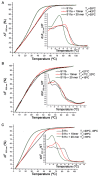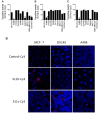Development, Characterization, and In Vivo Evaluation of a Novel Aptamer (Anti-MUC1/Y) for Breast Cancer Therapy
- PMID: 34452200
- PMCID: PMC8400696
- DOI: 10.3390/pharmaceutics13081239
Development, Characterization, and In Vivo Evaluation of a Novel Aptamer (Anti-MUC1/Y) for Breast Cancer Therapy
Abstract
MUC1, the transmembrane glycoprotein Mucin 1, is usually found to be overexpressed in a variety of epithelial cancers playing an important role in disease progression. MUC1 isoforms such as MUC1/Y, which lacks the entire variable number of tandem repeat region, are involved in oncogenic processes by enhancing tumour initiation. MUC1/Y is therefore considered a promising target for the identification and treatment of epithelial cancers; but so far, the precise role of MUC1/Y remains to be elucidated. In this work, we developed and identified a DNA aptamer that specifically recognizes the splice variant MUC1/Y for the first time. The DNA aptamer could bind to a wide variety of human cancer cells, and treatment of MUC1/Y positive cells resulted in reduced growth in vitro. Moreover, MUC1/Y aptamer inhibited the tumour growth of breast cancer cells in vivo. The present study highlights the importance of targeting MUC1/Y for cancer treatment and unravels the suitability of a DNA aptamer to act as a new therapeutic tool.
Keywords: MUC1/Y; aptamer; cancer; pharmacokinetics; therapy.
Conflict of interest statement
The authors declare no conflict of interest concerning this article.
Figures






Similar articles
-
MUC1 isoform specific monoclonal antibody 6E6/2 detects preferential expression of the novel MUC1/Y protein in breast and ovarian cancer.Int J Cancer. 1999 Jul 19;82(2):256-67. doi: 10.1002/(sici)1097-0215(19990719)82:2<256::aid-ijc17>3.0.co;2-c. Int J Cancer. 1999. PMID: 10389761
-
Characterization and molecular cloning of a novel MUC1 protein, devoid of tandem repeats, expressed in human breast cancer tissue.Eur J Biochem. 1994 Sep 1;224(2):787-95. doi: 10.1111/j.1432-1033.1994.00787.x. Eur J Biochem. 1994. PMID: 7925397
-
Aptamer-guided DNA tetrahedron as a novel targeted drug delivery system for MUC1-expressing breast cancer cells in vitro.Oncotarget. 2016 Jun 21;7(25):38257-38269. doi: 10.18632/oncotarget.9431. Oncotarget. 2016. PMID: 27203221 Free PMC article.
-
Anti-MUC1 aptamer: A potential opportunity for cancer treatment.Med Res Rev. 2017 Nov;37(6):1518-1539. doi: 10.1002/med.21462. Epub 2017 Jul 31. Med Res Rev. 2017. PMID: 28759115 Review.
-
Aptasensors as a new sensing technology developed for the detection of MUC1 mucin: A review.Biosens Bioelectron. 2019 Apr 1;130:1-19. doi: 10.1016/j.bios.2019.01.015. Epub 2019 Jan 15. Biosens Bioelectron. 2019. PMID: 30716589 Review.
Cited by
-
Mucin 1 downregulation decreases the anti-tumor effects of melanoma vaccine.Ann Transl Med. 2022 Dec;10(24):1361. doi: 10.21037/atm-22-6170. Ann Transl Med. 2022. PMID: 36660692 Free PMC article.
-
A Possible Inhibitory Role of Sialic Acid on MUC1 in Peritoneal Dissemination of Clear Cell-Type Ovarian Cancer Cells.Molecules. 2021 Oct 1;26(19):5962. doi: 10.3390/molecules26195962. Molecules. 2021. PMID: 34641504 Free PMC article.
-
MUC1 is a potential target to overcome trastuzumab resistance in breast cancer therapy.Cancer Cell Int. 2022 Mar 5;22(1):110. doi: 10.1186/s12935-022-02523-z. Cancer Cell Int. 2022. PMID: 35248049 Free PMC article. Review.
-
Circulating Tumor Cells Adhesion: Application in Biosensors.Biosensors (Basel). 2023 Sep 12;13(9):882. doi: 10.3390/bios13090882. Biosensors (Basel). 2023. PMID: 37754116 Free PMC article. Review.
References
LinkOut - more resources
Full Text Sources
Research Materials
Miscellaneous

